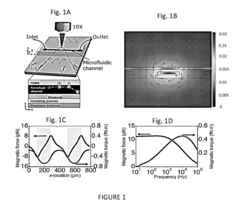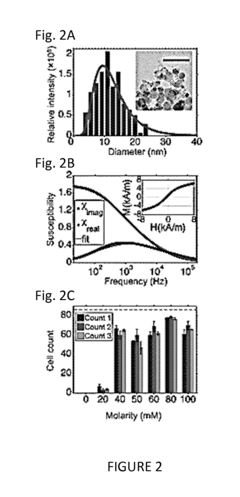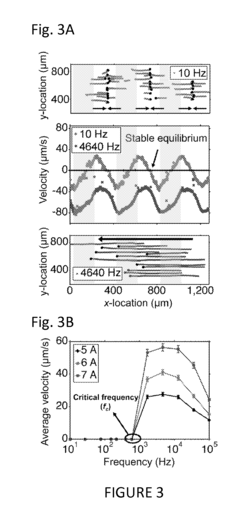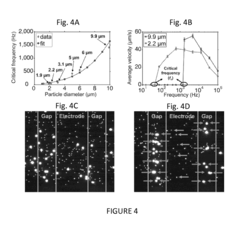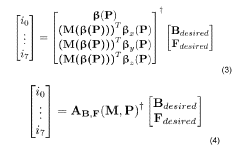Exploring Ferrofluid's Application in Precision Medical Techniques
JUL 9, 202510 MIN READ
Generate Your Research Report Instantly with AI Agent
Patsnap Eureka helps you evaluate technical feasibility & market potential.
Ferrofluid in Medicine: Background and Objectives
Ferrofluids, a unique class of magnetic nanomaterials, have emerged as a promising frontier in precision medical techniques. These colloidal suspensions of magnetic nanoparticles in a carrier fluid exhibit remarkable responsiveness to external magnetic fields, offering unprecedented control and manipulation at the microscale. The development of ferrofluids dates back to the 1960s when NASA scientist Steve Papell first synthesized them for rocket fuel applications. However, their potential in medicine has only recently begun to be fully explored and realized.
The evolution of ferrofluid technology in medicine has been driven by advancements in nanotechnology, materials science, and bioengineering. Early medical applications focused on magnetic drug targeting and hyperthermia treatments for cancer. As research progressed, the scope expanded to include contrast agents for magnetic resonance imaging (MRI), cell separation techniques, and biosensors. The miniaturization of medical devices and the growing demand for minimally invasive procedures have further accelerated interest in ferrofluid-based solutions.
The primary objective of exploring ferrofluid applications in precision medical techniques is to leverage their unique properties for enhanced diagnostic and therapeutic interventions. Researchers aim to develop novel methods for targeted drug delivery, improve the sensitivity and specificity of imaging modalities, and create innovative tools for tissue engineering and regenerative medicine. The ultimate goal is to enable more personalized and effective medical treatments while minimizing side effects and invasiveness.
Current technological trends in ferrofluid research for medical applications include the development of biocompatible and biodegradable ferrofluids, surface functionalization for improved targeting and reduced toxicity, and the integration of ferrofluids with other advanced materials and technologies such as microfluidics and nanosensors. Additionally, there is a growing focus on understanding and optimizing the interaction between ferrofluids and biological systems at the cellular and molecular levels.
The potential impact of ferrofluid-based technologies on healthcare is significant. They promise to revolutionize cancer treatment through more precise and localized therapies, enhance diagnostic imaging capabilities for early disease detection, and enable new approaches to tissue regeneration and wound healing. Furthermore, ferrofluids could play a crucial role in the development of next-generation medical devices, including smart implants and minimally invasive surgical tools.
As research in this field progresses, interdisciplinary collaboration between physicists, chemists, biologists, and medical professionals will be essential to overcome current limitations and fully realize the potential of ferrofluids in precision medicine. The convergence of nanotechnology, biotechnology, and medical science is expected to drive further innovations, paving the way for transformative advances in healthcare delivery and patient outcomes.
The evolution of ferrofluid technology in medicine has been driven by advancements in nanotechnology, materials science, and bioengineering. Early medical applications focused on magnetic drug targeting and hyperthermia treatments for cancer. As research progressed, the scope expanded to include contrast agents for magnetic resonance imaging (MRI), cell separation techniques, and biosensors. The miniaturization of medical devices and the growing demand for minimally invasive procedures have further accelerated interest in ferrofluid-based solutions.
The primary objective of exploring ferrofluid applications in precision medical techniques is to leverage their unique properties for enhanced diagnostic and therapeutic interventions. Researchers aim to develop novel methods for targeted drug delivery, improve the sensitivity and specificity of imaging modalities, and create innovative tools for tissue engineering and regenerative medicine. The ultimate goal is to enable more personalized and effective medical treatments while minimizing side effects and invasiveness.
Current technological trends in ferrofluid research for medical applications include the development of biocompatible and biodegradable ferrofluids, surface functionalization for improved targeting and reduced toxicity, and the integration of ferrofluids with other advanced materials and technologies such as microfluidics and nanosensors. Additionally, there is a growing focus on understanding and optimizing the interaction between ferrofluids and biological systems at the cellular and molecular levels.
The potential impact of ferrofluid-based technologies on healthcare is significant. They promise to revolutionize cancer treatment through more precise and localized therapies, enhance diagnostic imaging capabilities for early disease detection, and enable new approaches to tissue regeneration and wound healing. Furthermore, ferrofluids could play a crucial role in the development of next-generation medical devices, including smart implants and minimally invasive surgical tools.
As research in this field progresses, interdisciplinary collaboration between physicists, chemists, biologists, and medical professionals will be essential to overcome current limitations and fully realize the potential of ferrofluids in precision medicine. The convergence of nanotechnology, biotechnology, and medical science is expected to drive further innovations, paving the way for transformative advances in healthcare delivery and patient outcomes.
Market Analysis for Ferrofluid-Based Medical Solutions
The market for ferrofluid-based medical solutions is experiencing significant growth, driven by the increasing demand for precision medical techniques. Ferrofluids, which are colloidal liquids containing magnetic nanoparticles, offer unique properties that make them particularly suitable for various medical applications.
In the field of targeted drug delivery, ferrofluids show great promise. The global targeted drug delivery market is expected to reach substantial value in the coming years, with ferrofluid-based solutions poised to capture a significant share. This growth is fueled by the rising prevalence of chronic diseases and the need for more effective, localized treatments with fewer side effects.
Magnetic Resonance Imaging (MRI) contrast agents represent another key market segment for ferrofluid applications. The global MRI contrast agents market is projected to expand steadily, with ferrofluid-based contrast agents gaining traction due to their superior imaging capabilities and potential for reduced toxicity compared to traditional gadolinium-based agents.
In the realm of hyperthermia treatment for cancer, ferrofluids are emerging as a promising tool. The global cancer hyperthermia treatment market is anticipated to grow significantly, with ferrofluid-based solutions expected to play a crucial role in enhancing treatment efficacy and reducing side effects.
The market for ferrofluid-based biosensors is also on the rise, driven by the increasing need for rapid, sensitive, and accurate diagnostic tools. This segment is particularly relevant in the context of point-of-care testing and early disease detection, areas that are seeing substantial investment and growth.
Geographically, North America and Europe currently lead the market for ferrofluid-based medical solutions, owing to their advanced healthcare infrastructure and higher adoption rates of innovative medical technologies. However, the Asia-Pacific region is expected to witness the fastest growth in the coming years, driven by increasing healthcare expenditure, growing awareness of precision medicine, and improving research and development capabilities.
Key market players in this space include both established medical technology companies and innovative startups. These companies are actively investing in research and development to expand the applications of ferrofluids in medicine and improve existing solutions. Collaborations between academic institutions and industry partners are also accelerating the development and commercialization of ferrofluid-based medical technologies.
Despite the promising outlook, challenges remain in the widespread adoption of ferrofluid-based medical solutions. These include regulatory hurdles, the need for extensive clinical trials to prove long-term safety and efficacy, and the initial high costs associated with developing and implementing these advanced technologies. However, as research progresses and more clinical data becomes available, these barriers are expected to diminish, paving the way for broader market penetration and acceptance of ferrofluid-based medical solutions.
In the field of targeted drug delivery, ferrofluids show great promise. The global targeted drug delivery market is expected to reach substantial value in the coming years, with ferrofluid-based solutions poised to capture a significant share. This growth is fueled by the rising prevalence of chronic diseases and the need for more effective, localized treatments with fewer side effects.
Magnetic Resonance Imaging (MRI) contrast agents represent another key market segment for ferrofluid applications. The global MRI contrast agents market is projected to expand steadily, with ferrofluid-based contrast agents gaining traction due to their superior imaging capabilities and potential for reduced toxicity compared to traditional gadolinium-based agents.
In the realm of hyperthermia treatment for cancer, ferrofluids are emerging as a promising tool. The global cancer hyperthermia treatment market is anticipated to grow significantly, with ferrofluid-based solutions expected to play a crucial role in enhancing treatment efficacy and reducing side effects.
The market for ferrofluid-based biosensors is also on the rise, driven by the increasing need for rapid, sensitive, and accurate diagnostic tools. This segment is particularly relevant in the context of point-of-care testing and early disease detection, areas that are seeing substantial investment and growth.
Geographically, North America and Europe currently lead the market for ferrofluid-based medical solutions, owing to their advanced healthcare infrastructure and higher adoption rates of innovative medical technologies. However, the Asia-Pacific region is expected to witness the fastest growth in the coming years, driven by increasing healthcare expenditure, growing awareness of precision medicine, and improving research and development capabilities.
Key market players in this space include both established medical technology companies and innovative startups. These companies are actively investing in research and development to expand the applications of ferrofluids in medicine and improve existing solutions. Collaborations between academic institutions and industry partners are also accelerating the development and commercialization of ferrofluid-based medical technologies.
Despite the promising outlook, challenges remain in the widespread adoption of ferrofluid-based medical solutions. These include regulatory hurdles, the need for extensive clinical trials to prove long-term safety and efficacy, and the initial high costs associated with developing and implementing these advanced technologies. However, as research progresses and more clinical data becomes available, these barriers are expected to diminish, paving the way for broader market penetration and acceptance of ferrofluid-based medical solutions.
Current Challenges in Ferrofluid Medical Applications
Despite the promising potential of ferrofluids in precision medical techniques, several significant challenges currently hinder their widespread application in clinical settings. One of the primary obstacles is the biocompatibility of ferrofluids. While efforts have been made to develop biocompatible ferrofluids, ensuring long-term safety and preventing potential toxicity remains a critical concern. The interaction between ferrofluid nanoparticles and biological systems needs to be thoroughly understood and optimized to mitigate any adverse effects on human health.
Another challenge lies in the stability of ferrofluids under physiological conditions. The complex environment within the human body, including varying pH levels, temperature fluctuations, and the presence of proteins and other biomolecules, can significantly affect the stability and performance of ferrofluids. Maintaining the colloidal stability and magnetic properties of ferrofluids in such dynamic environments is crucial for their effective application in medical procedures.
The precise control and manipulation of ferrofluids within the body present another set of challenges. While external magnetic fields can be used to guide ferrofluids, achieving highly localized and accurate control, especially in deep tissues or complex anatomical structures, remains difficult. This limitation affects the precision of drug delivery, targeted therapies, and diagnostic imaging applications that rely on ferrofluid manipulation.
Furthermore, the scalability and reproducibility of ferrofluid production for medical applications pose significant hurdles. Ensuring consistent quality, particle size distribution, and magnetic properties across different batches is essential for reliable clinical outcomes. The current manufacturing processes often struggle to meet the stringent requirements for medical-grade ferrofluids at scale.
Regulatory challenges also play a crucial role in the adoption of ferrofluid-based medical technologies. The novel nature of these materials and their applications necessitates rigorous safety evaluations and clinical trials. Navigating the complex regulatory landscape and obtaining necessary approvals from health authorities can be time-consuming and resource-intensive, potentially slowing down the translation of ferrofluid technologies from laboratory to clinical practice.
Lastly, the integration of ferrofluid-based techniques with existing medical procedures and equipment presents technical and practical challenges. Developing compatible imaging systems, delivery devices, and treatment protocols that can effectively utilize ferrofluids while seamlessly integrating into current medical workflows requires significant interdisciplinary collaboration and innovation.
Another challenge lies in the stability of ferrofluids under physiological conditions. The complex environment within the human body, including varying pH levels, temperature fluctuations, and the presence of proteins and other biomolecules, can significantly affect the stability and performance of ferrofluids. Maintaining the colloidal stability and magnetic properties of ferrofluids in such dynamic environments is crucial for their effective application in medical procedures.
The precise control and manipulation of ferrofluids within the body present another set of challenges. While external magnetic fields can be used to guide ferrofluids, achieving highly localized and accurate control, especially in deep tissues or complex anatomical structures, remains difficult. This limitation affects the precision of drug delivery, targeted therapies, and diagnostic imaging applications that rely on ferrofluid manipulation.
Furthermore, the scalability and reproducibility of ferrofluid production for medical applications pose significant hurdles. Ensuring consistent quality, particle size distribution, and magnetic properties across different batches is essential for reliable clinical outcomes. The current manufacturing processes often struggle to meet the stringent requirements for medical-grade ferrofluids at scale.
Regulatory challenges also play a crucial role in the adoption of ferrofluid-based medical technologies. The novel nature of these materials and their applications necessitates rigorous safety evaluations and clinical trials. Navigating the complex regulatory landscape and obtaining necessary approvals from health authorities can be time-consuming and resource-intensive, potentially slowing down the translation of ferrofluid technologies from laboratory to clinical practice.
Lastly, the integration of ferrofluid-based techniques with existing medical procedures and equipment presents technical and practical challenges. Developing compatible imaging systems, delivery devices, and treatment protocols that can effectively utilize ferrofluids while seamlessly integrating into current medical workflows requires significant interdisciplinary collaboration and innovation.
Existing Ferrofluid-Based Medical Techniques
01 Composition and preparation of ferrofluids
Ferrofluids are colloidal suspensions of magnetic nanoparticles in a carrier fluid. They typically consist of magnetite or other ferromagnetic materials coated with surfactants to prevent agglomeration. The preparation process involves careful control of particle size and distribution to maintain stability and magnetic properties.- Composition and preparation of ferrofluids: Ferrofluids are colloidal suspensions of magnetic nanoparticles in a carrier fluid. They typically consist of magnetite or other ferromagnetic materials coated with surfactants to prevent agglomeration. The preparation process involves careful control of particle size and distribution to maintain stability and magnetic properties.
- Applications in sealing and lubrication: Ferrofluids are widely used in sealing and lubrication applications, particularly in rotating shaft seals. They provide a liquid barrier that can be controlled by magnetic fields, offering advantages in high-speed and vacuum environments. These applications benefit from the fluid's ability to maintain a seal while allowing rotation with minimal friction.
- Magnetic field sensing and control: Ferrofluids are utilized in various sensing and control applications that rely on their unique magnetic properties. They can be used to detect and measure magnetic fields, as well as to create controllable magnetic environments. This principle is applied in devices such as accelerometers, inclinometers, and adaptive optics systems.
- Thermal management applications: The magnetic properties of ferrofluids make them useful in thermal management systems. They can be used to enhance heat transfer in cooling systems, particularly in electronic devices. By applying magnetic fields, the fluid's flow and heat transfer characteristics can be controlled, allowing for more efficient cooling in compact spaces.
- Novel mechanical and optical applications: Ferrofluids find applications in various novel mechanical and optical devices. They are used in damping systems, variable-focus lenses, and display technologies. The ability to manipulate the fluid's shape and properties using magnetic fields enables the creation of adaptive and responsive systems in areas such as optics, robotics, and art installations.
02 Applications in sealing and lubrication
Ferrofluids are widely used in sealing and lubrication applications, particularly in rotating shaft seals. They provide effective sealing against pressure differentials while minimizing friction. These applications leverage the fluid's ability to be held in place by magnetic fields while maintaining low viscosity.Expand Specific Solutions03 Thermal management and cooling systems
Ferrofluids are employed in thermal management solutions, particularly for electronic devices. Their unique properties allow for efficient heat transfer when subjected to magnetic fields, making them suitable for cooling systems in various applications, including computers and power electronics.Expand Specific Solutions04 Damping and vibration control
The magnetic properties of ferrofluids make them useful in damping and vibration control applications. They can be used in shock absorbers, vibration isolators, and other mechanical systems to provide adaptive damping characteristics in response to applied magnetic fields.Expand Specific Solutions05 Sensing and measurement applications
Ferrofluids are utilized in various sensing and measurement devices. Their response to magnetic fields and ability to change shape or position makes them suitable for applications such as accelerometers, inclinometers, and pressure sensors. They can also be used in magnetic field visualization and measurement tools.Expand Specific Solutions
Key Players in Ferrofluid Medical Research
The field of ferrofluid applications in precision medical techniques is in an early growth stage, with significant potential for expansion. The market size is relatively small but growing rapidly as researchers and companies explore novel uses in targeted drug delivery, magnetic hyperthermia, and medical imaging. Technologically, the field is still maturing, with ongoing research to optimize ferrofluid properties and biocompatibility. Key players like Yale University, Koninklijke Philips NV, and Peking University are driving innovation through academic research, while companies such as DIAGAST SAS and Nano4Imaging GmbH are developing commercial applications. The competitive landscape is diverse, with collaborations between academia and industry accelerating progress in this promising field.
Yale University
Technical Solution: Yale University has been at the forefront of ferrofluid research for precision medical techniques. Their approach involves developing magnetically-guided drug delivery systems using ferrofluids. The university's researchers have created nanoparticle-based ferrofluids that can be precisely controlled by external magnetic fields to target specific areas in the body[1]. This technology allows for localized drug delivery, potentially reducing side effects and improving treatment efficacy. Yale's team has also explored the use of ferrofluids in magnetic resonance imaging (MRI) contrast agents, enhancing image quality and diagnostic accuracy[2]. Their recent work focuses on combining ferrofluids with biodegradable polymers to create smart, responsive drug delivery vehicles that can be triggered by both magnetic fields and physiological conditions[3].
Strengths: Cutting-edge research in targeted drug delivery and improved medical imaging. Weaknesses: Potential challenges in scaling up production and ensuring long-term stability of ferrofluid formulations in biological environments.
Koninklijke Philips NV
Technical Solution: Koninklijke Philips NV has integrated ferrofluid technology into their advanced medical imaging systems. Their approach focuses on enhancing the performance of MRI machines by using ferrofluids as dynamic seals in the rotating components of the scanners[4]. This application improves the overall efficiency and reliability of MRI systems. Additionally, Philips has explored the use of ferrofluids in novel contrast agents for both MRI and computed tomography (CT) imaging. Their research has shown promising results in developing ferrofluid-based nanoprobes that can provide multimodal imaging capabilities, allowing for more accurate diagnosis and treatment planning[5]. Philips is also investigating the potential of ferrofluids in minimally invasive surgical techniques, where magnetically-guided ferrofluid droplets could be used for precise tissue manipulation or as markers for tumor localization[6].
Strengths: Strong integration of ferrofluid technology in existing medical imaging systems and potential for new diagnostic tools. Weaknesses: May face regulatory challenges in introducing new ferrofluid-based medical devices to the market.
Innovative Ferrofluid Applications in Precision Medicine
Label-Free Cellular Manipulation and Sorting Via Biocompatible Ferrofluids
PatentActiveUS20180128729A1
Innovation
- A microfluidic platform using biocompatible ferrofluids with a microfluidic channel and electrodes that generate a magnetic field pattern, allowing for the controlled manipulation and separation of microparticles and live cells based on size, shape, and elasticity, with high efficiency and rapid separation capabilities.
Systems and methods for controlling shape and position of a ferrofluid droplet
PatentWO2021041471A1
Innovation
- A system comprising a ferrofluid droplet and an electromagnetic field generation system with a controller that determines and applies necessary magnetic field parameters to control the position and shape of the ferrofluid droplet, using PID controllers for precise manipulation, allowing for shape and position control, and simultaneous position and shape control through the generation and manipulation of controlled magnetic fields.
Regulatory Framework for Ferrofluid Medical Devices
The regulatory framework for ferrofluid medical devices is a complex and evolving landscape that requires careful navigation by manufacturers, researchers, and healthcare providers. As ferrofluids gain traction in precision medical techniques, regulatory bodies worldwide are adapting their guidelines to address the unique properties and potential risks associated with these innovative materials.
In the United States, the Food and Drug Administration (FDA) plays a pivotal role in regulating ferrofluid-based medical devices. These devices typically fall under Class II or Class III classifications, depending on their intended use and risk profile. The FDA's Center for Devices and Radiological Health (CDRH) oversees the premarket approval process, which includes rigorous safety and efficacy evaluations. Manufacturers must demonstrate compliance with Good Manufacturing Practices (GMP) and provide comprehensive data on biocompatibility, stability, and performance of ferrofluid components.
The European Union's regulatory approach is governed by the Medical Device Regulation (MDR) and In Vitro Diagnostic Regulation (IVDR). These regulations emphasize a risk-based classification system and require manufacturers to implement a robust quality management system. For ferrofluid devices, particular attention is given to the unique interactions between the magnetic nanoparticles and biological tissues, necessitating extensive clinical evidence and post-market surveillance.
In Japan, the Pharmaceuticals and Medical Devices Agency (PMDA) oversees the approval process for ferrofluid medical devices. The Japanese regulatory framework emphasizes the importance of quality control and places significant weight on local clinical data, which can present challenges for international manufacturers seeking market entry.
Globally, the International Organization for Standardization (ISO) has developed several standards relevant to ferrofluid medical devices, including ISO 13485 for quality management systems and ISO 10993 for biological evaluation of medical devices. These standards provide a foundation for harmonizing regulatory requirements across different regions and facilitating international trade.
As the field of ferrofluid applications in medicine continues to advance, regulatory bodies are increasingly focusing on the long-term safety implications of these materials. This includes considerations for potential nanoparticle accumulation in organs, interactions with magnetic fields in diagnostic imaging, and the environmental impact of ferrofluid disposal. Manufacturers are required to conduct extensive toxicology studies and develop robust risk management strategies to address these concerns.
The regulatory landscape also encompasses specific guidelines for the manufacturing processes of ferrofluids, including controls for particle size distribution, magnetic properties, and surface functionalization. These parameters are critical for ensuring consistent performance and safety in medical applications. Additionally, regulatory frameworks are evolving to address the use of ferrofluids in combination products, where the material may be used in conjunction with drugs or biologics, requiring a more complex regulatory pathway.
In the United States, the Food and Drug Administration (FDA) plays a pivotal role in regulating ferrofluid-based medical devices. These devices typically fall under Class II or Class III classifications, depending on their intended use and risk profile. The FDA's Center for Devices and Radiological Health (CDRH) oversees the premarket approval process, which includes rigorous safety and efficacy evaluations. Manufacturers must demonstrate compliance with Good Manufacturing Practices (GMP) and provide comprehensive data on biocompatibility, stability, and performance of ferrofluid components.
The European Union's regulatory approach is governed by the Medical Device Regulation (MDR) and In Vitro Diagnostic Regulation (IVDR). These regulations emphasize a risk-based classification system and require manufacturers to implement a robust quality management system. For ferrofluid devices, particular attention is given to the unique interactions between the magnetic nanoparticles and biological tissues, necessitating extensive clinical evidence and post-market surveillance.
In Japan, the Pharmaceuticals and Medical Devices Agency (PMDA) oversees the approval process for ferrofluid medical devices. The Japanese regulatory framework emphasizes the importance of quality control and places significant weight on local clinical data, which can present challenges for international manufacturers seeking market entry.
Globally, the International Organization for Standardization (ISO) has developed several standards relevant to ferrofluid medical devices, including ISO 13485 for quality management systems and ISO 10993 for biological evaluation of medical devices. These standards provide a foundation for harmonizing regulatory requirements across different regions and facilitating international trade.
As the field of ferrofluid applications in medicine continues to advance, regulatory bodies are increasingly focusing on the long-term safety implications of these materials. This includes considerations for potential nanoparticle accumulation in organs, interactions with magnetic fields in diagnostic imaging, and the environmental impact of ferrofluid disposal. Manufacturers are required to conduct extensive toxicology studies and develop robust risk management strategies to address these concerns.
The regulatory landscape also encompasses specific guidelines for the manufacturing processes of ferrofluids, including controls for particle size distribution, magnetic properties, and surface functionalization. These parameters are critical for ensuring consistent performance and safety in medical applications. Additionally, regulatory frameworks are evolving to address the use of ferrofluids in combination products, where the material may be used in conjunction with drugs or biologics, requiring a more complex regulatory pathway.
Biocompatibility and Safety Considerations
The application of ferrofluids in precision medical techniques necessitates a thorough examination of biocompatibility and safety considerations. Ferrofluids, composed of magnetic nanoparticles suspended in a carrier fluid, present unique challenges when introduced into biological systems.
One primary concern is the potential toxicity of the nanoparticles. The size, shape, and surface properties of these particles can significantly influence their interactions with cells and tissues. Smaller particles may penetrate cell membranes more easily, potentially causing cellular damage or disrupting normal functions. Conversely, larger particles might accumulate in specific organs, leading to long-term health effects.
The chemical composition of the nanoparticles also plays a crucial role in biocompatibility. Iron oxide nanoparticles, commonly used in ferrofluids, have shown relatively low toxicity in many studies. However, the coating materials used to stabilize these particles in the carrier fluid must be carefully selected to ensure they do not trigger adverse reactions in the body.
Immune system responses to ferrofluids are another critical aspect to consider. The introduction of foreign particles can potentially activate the immune system, leading to inflammation or allergic reactions. Long-term studies are necessary to fully understand the body's response to prolonged exposure to ferrofluids and to develop strategies to mitigate any negative effects.
The biodegradation and clearance of ferrofluids from the body are essential factors in assessing their safety. Ideally, the nanoparticles should be eliminated from the body within a reasonable timeframe to prevent accumulation and potential long-term toxicity. The route of elimination, whether through renal or hepatic pathways, must be thoroughly investigated to ensure efficient clearance without causing damage to these organ systems.
Magnetic field interactions present another unique safety consideration for ferrofluids in medical applications. While the magnetic properties of these fluids are central to their functionality, the potential effects of external magnetic fields on ferrofluid-treated tissues must be carefully evaluated. This includes assessing the risk of particle migration or aggregation under the influence of strong magnetic fields, such as those used in MRI scans.
Standardization of safety protocols and testing procedures for ferrofluid-based medical technologies is crucial. This includes developing comprehensive in vitro and in vivo testing methodologies to assess cytotoxicity, genotoxicity, and systemic effects. Additionally, long-term follow-up studies on patients treated with ferrofluid-based therapies will be essential to identify any delayed or cumulative effects.
As research in this field progresses, continuous refinement of ferrofluid formulations to enhance biocompatibility while maintaining desired functional properties will be necessary. This may involve exploring novel nanoparticle compositions, surface modifications, or carrier fluids that offer improved safety profiles without compromising the unique characteristics that make ferrofluids valuable in precision medical applications.
One primary concern is the potential toxicity of the nanoparticles. The size, shape, and surface properties of these particles can significantly influence their interactions with cells and tissues. Smaller particles may penetrate cell membranes more easily, potentially causing cellular damage or disrupting normal functions. Conversely, larger particles might accumulate in specific organs, leading to long-term health effects.
The chemical composition of the nanoparticles also plays a crucial role in biocompatibility. Iron oxide nanoparticles, commonly used in ferrofluids, have shown relatively low toxicity in many studies. However, the coating materials used to stabilize these particles in the carrier fluid must be carefully selected to ensure they do not trigger adverse reactions in the body.
Immune system responses to ferrofluids are another critical aspect to consider. The introduction of foreign particles can potentially activate the immune system, leading to inflammation or allergic reactions. Long-term studies are necessary to fully understand the body's response to prolonged exposure to ferrofluids and to develop strategies to mitigate any negative effects.
The biodegradation and clearance of ferrofluids from the body are essential factors in assessing their safety. Ideally, the nanoparticles should be eliminated from the body within a reasonable timeframe to prevent accumulation and potential long-term toxicity. The route of elimination, whether through renal or hepatic pathways, must be thoroughly investigated to ensure efficient clearance without causing damage to these organ systems.
Magnetic field interactions present another unique safety consideration for ferrofluids in medical applications. While the magnetic properties of these fluids are central to their functionality, the potential effects of external magnetic fields on ferrofluid-treated tissues must be carefully evaluated. This includes assessing the risk of particle migration or aggregation under the influence of strong magnetic fields, such as those used in MRI scans.
Standardization of safety protocols and testing procedures for ferrofluid-based medical technologies is crucial. This includes developing comprehensive in vitro and in vivo testing methodologies to assess cytotoxicity, genotoxicity, and systemic effects. Additionally, long-term follow-up studies on patients treated with ferrofluid-based therapies will be essential to identify any delayed or cumulative effects.
As research in this field progresses, continuous refinement of ferrofluid formulations to enhance biocompatibility while maintaining desired functional properties will be necessary. This may involve exploring novel nanoparticle compositions, surface modifications, or carrier fluids that offer improved safety profiles without compromising the unique characteristics that make ferrofluids valuable in precision medical applications.
Unlock deeper insights with Patsnap Eureka Quick Research — get a full tech report to explore trends and direct your research. Try now!
Generate Your Research Report Instantly with AI Agent
Supercharge your innovation with Patsnap Eureka AI Agent Platform!
